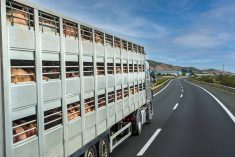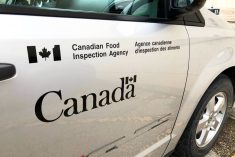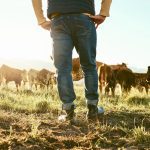A new study from a well-known pro-free-market think tank criticizes British Columbia’s Agricultural Land Reserve (ALR) as a “social engineering experiment gone awry” that’s done little more than put Vancouver housing prices increasingly out of reach.
The Fraser Institute’s report, released Monday, says B.C.’s ALR “has not encouraged family farming. It has not nurtured a new generation of farm operators. Nor has it shielded the farm sector from changes in agriculture experienced across Canada and around the world.”
Instead, according to study author Diane Katz, the institute’s director of risk, environment, and energy policy, the ALR “has enabled the government to manipulate the farmland inventory, with the result that the cost of agricultural land is now beyond the reach of a new generation.”
Read Also

U.S. livestock: ‘Cattle on feed’ report supports prices
Chicago cattle futures rose as the USDA’s ‘Cattle on Feed’ report showed inventories two per cent down from a year…
“While some advocates regard the ALR as sacrosanct, it is entirely reasonable for citizens to question the legitimacy of a regime by which the government deprives property owners of the use of their land — and the public of the tremendous benefits of markets — in order to indulge special interest groups that expect the general populace to shoulder the costs of their preferences,” Katz wrote.
“Good intentions alone do not constitute sound policy,” she wrote, and in the case of the ALR “substantial direct costs of the presumed public good… have been foisted upon a minority of citizens, and the indirect costs have fallen disproportionately upon those who can least afford them.”
The B.C. government set up the ALR between 1974 and 1976 as a “special” land use zone in response to “the serious erosion of our agricultural land base,” according to the province. Up to the 1970s, the province said, almost 15,000 acres of prime farmland were lost each year to urban and other uses.
The ALR covers about 11.6 million acres in which agriculture is recognized as the “priority use,” farming is encouraged and non-ag uses are regulated, the province said.
Despite boundary changes over the decades, the ALR’s area remains about the same, covering about five per cent of the province.
Declined
Proponents of the ALR “have variously argued that government control of farmland is necessary to protect family farms, preserve green space, and ensure a local food supply,” Katz wrote in the Fraser Institute study.
A ban on subdivision or development of ALR land has not helped develop a new generation of farmers, she wrote, finding the number of farms in B.C. has declined nine per cent since 1996, while the number of non-family corporation farms has increased 7.7 per cent.
The proportion of owner-operators is also falling, Katz wrote, with the total amount of B.C. farm area rented or leased growing by 35 per cent between 1986 and 2006.
Furthermore, she wrote, the resulting scarcity of land has done nothing but raise Vancouver’s housing costs, raise the average age of the city’s population and reduce the number of families living in it.
“Younger families at the beginning of their careers, and thus at the lower end of the income scale, are hit particularly hard by higher housing prices,” she added, citing census data to show almost 54 per cent of Vancouver-area homeowners under the age of 25 paid 30 per cent or more of their income on shelter compared to about 19 per cent of those aged 55-64.
Expanding
The farm sector, she added, “was expanding to meet the demands of a growing population long before the land reserve was imposed.” Farm area in B.C. actually increased 29 per cent between 1951 and 1976; acres devoted to vegetables increased 604 per cent between 1921 and 1976; the number of cattle increased 230 per cent, and hens and chickens increased 397 per cent.
“In fact, there was more farmland dedicated to field crops and vegetables before than after the advent of the ALR,” Katz said.
Advances in agronomy and biotechnology have also “dramatically” increased yields and eased demand for farmland, she wrote. “Reflecting a process of land substitution, for example, B.C.’s greenhouse area grew 31 per cent between 1986 and 2006. After three decades of the ALR regime, B.C. farmers produce just a third of the food needed in the province to meet the standards of a healthy diet.”
Katz’s study also aims to refute claims that farmland needs to be protected to assure B.C.’s “safe, local food supply.”
“The current fashionable stream of thought is that locally produced food is safer, healthier and better for the environment,” she wrote. “But evidence clearly shows this is fanciful thinking and many B.C. consumers have shown an undeniable preference for a greater choice of products.”
The institute’s study says most B.C. consumers buy “great quantities” of imported food and base decisions on factors including price, variety and convenience, not just on origin.
As well, Katz wrote, “the simple notion of adding up so-called ‘food miles’… does not account for the variety of inputs necessary for agriculture, such as energy, irrigation and fertilizer. Consequently, foods grown outside the province may, in fact, have less environmental impact.”
Katz also cited research showing the most significant cost of “food miles” is consumers’ trips to the store, not the commercial distribution of food, and if more consumers rely on unprocessed, locally-grown agricultural products, meaning more frequent trips to the store and longer trips to farms and farmers’ markets, the more food miles would increase.
The comparative advantages of Canada’s trading partners also allow Canadians to enjoy coffee and bananas from Colombia, wine and cheese from France, gin from Britain and rice from India, Katz said, just as Canada produces various products more efficiently than others do elsewhere.
“Time-tested”
Terminating the ALR “need not mean the end of farmland preservation,” Katz emphasized in her recommendations. “There already exists a network of accomplished land conservancies throughout Canada. With adjustments to the federal and provincial tax codes, this network could engage in significant farmland preservation. Relying on private organizations to achieve policy objectives is a time-tested approach.”
In the interim, she recommended, property owners within the ALR should at least be granted the option of excluding their land, based on criteria such as proof of ownership predating ALR designation, and a demonstration that the property is more valuable outside the ALR.
The province’s Agricultural Land Commission, which now oversees the ALR, could then be granted the authority to negotiate a purchase of the property if it wanted to preserve it as farmland.















